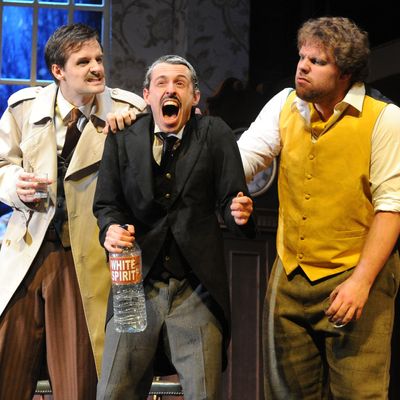
Farce is not an acquired taste; even babies laugh at pratfalls. Rather, farce is the taste you fail to grow out of — and thank God, because sometimes only the stupidest fun will do. If this is one of those times, then “stupidest fun” should probably be plastered on the walls of the Lyceum, where The Play That Goes Wrong, a backstage comedy created by England’s Mischief Theatre Company, is opening tonight. It’s so ridiculous it makes you feel almost ashamed to love it.
But shamelessness is part of the job description of being human. Certainly the members of the (fictional) Cornley Polytechnic Drama Society are beyond embarrassment. These half-wit amateurs, whose understaffed previous productions have included Two Sisters and Cat, have now turned their attention to a (fictional) 1922 murder mystery called The Murder at Haversham Manor by one Susie H. K. Brideswell. (The actual play is by Mischief ensemble members Henry Lewis, Jonathan Sayer, and Henry Shields, all of whom appear in the production.) What we see onstage at the Lyceum is the Cornley’s attempt to get through opening night of the wheezy Mousetrap-like chestnut despite every kind of theatrical mishap that has ever been turned into a fond war story. These include, of course, missed sound cues and malfunctioning manor-house sets, but to say that is like saying Götterdämmerung includes drama and ditties. The disasters that befall the play within The Play That Goes Wrong are cataclysmic: the nearly fatal collapse of a second-floor study, a prop mixup replacing Scotch with turpentine, and a leading lady who, having been knocked unconscious, is replaced by the stage manager until she, too, is knocked unconscious. The role then goes to a sound technician and, eventually, a grandfather clock.
The tumble from slapstick into absurdity — or is it an elevation? — is the best part of The Play That Goes Wrong, and the part that is most reminiscent of such great English-language farces as Noises Off (wonderfully revived last year at the Roundabout) and even The Importance of Being Earnest. Comedies like these at some point achieve a kind of liftoff that leaves their specific circumstances far below as the characters find themselves trapped in orbit in verbal dilemmas that approximate the existential ones of characters in Beckett. They happen most wonderfully in The Play That Goes Wrong at two especially hilarious moments. In one, a scene between the police inspector and the young woman whose fiancé has been murdered slips out of sync for more than a page when the actress jumps her cue:
FLORENCE COLLEYMOORE: When you love someone there’s no such thing as rushing, Inspector.
INSPECTOR CARTER: Did you ever think you were rushing into this marriage?
FLORENCE COLLEYMOORE: Why wouldn’t I love him?
INSPECTOR CARTER: Did you love him, then?
Later, the idea is elaborated when four of the actors get lost in a Groundhog Day loop of idiotic dialogue that repeats and repeats with mounting hysteria as they desperately look for a way out. In such moments, The Play That Goes Wrong uses purely formal means — not stage tricks — to exploit the anxiety of existence for great humor.
Not that the stage tricks aren’t fun; who doesn’t love to see a floorboard spring out of the floor and whack an actor in the face? Or, for that matter, see that same ninny actor so thrilled when he gets a laugh that he can’t stop beaming — and trying for more? (That’s Dave Hearn stealing the show as Max Bennett, who plays Cecil Haversham, the dead man’s brother.) But those tricks and carefully rehearsed ineptitudes are not, in the end, deeply satisfying, however well achieved they are. (Nigel Hook’s booby-trapped set should get either a Tony award or a cease-and-desist order from OSHA.) They’re mechanical and shocking where the greatest farces are spiritual and inevitable.
The authors seem to understand this in theory; in a note to the script they write that “the Cornley Polytechnic Drama Society are not bad actors” and that the comedy works best when it is presented as “‘the play that goes wrong,’ not ‘the play that’s being done badly.’” You see that in bits like the one when the elevator to the second-floor study breaks down, forcing the actors to ad lib a set of stairs that doesn’t exist, then “climb down” it sublimely. But for the most part the production doesn’t bear that out. The tech guy (Rob Falconer) is a boob who misses his cues because he’s playing with his smartphone; the costumes (by Roberto Surace) are intentionally awful; and the acting by the Cornley players is sub-high-school grotesque. Charlie Russell as Sandra Wilkinson as Florence the bereaved fiancée gives us Martha Graham crossed with epilepsy when she’s having her emotional “episodes”; Jonathan Sayer as Dennis Tyde as Perkins the Butler frequently “breaks” — cracks up out of character — in an obviously studied way to delight the audience. He also mispronounces ordinary words like ominous and façade, the latter somehow turned into an unlikely vulgarity.
Though they let too much air out of the concept, shriveling somewhat its effectiveness and diminishing it buoyancy, I laughed at all of those things, much in the way I laugh at the anything-goes attitude of Fawlty Towers. (With his slow burn and megalomaniacal tendencies, Henry Shields as the inner show’s director, producer, designer, and lead performer may remind you of John Cleese.) And I guess the Mischief folks know what they’re doing; the show has run continuously at various London venues since its premiere in 2012, and they’ve had follow-up hits there with a similarly conceived Peter Pan Goes Wrong and a non-Cornley play called The Comedy About a Bank Robbery. To plump for a purer version of farce thus seems farcical in itself, and also ungrateful. Why ask for the moon? We have the stairs.
The Play That Goes Wrong is at the Lyceum Theatre.

